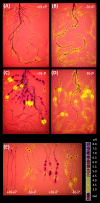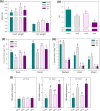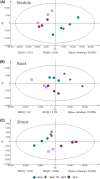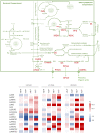Nodulating white lupins take advantage of the reciprocal interplay between N and P nutritional responses
- PMID: 34837246
- PMCID: PMC9303408
- DOI: 10.1111/ppl.13607
Nodulating white lupins take advantage of the reciprocal interplay between N and P nutritional responses
Abstract
The low bioavailability of nutrients, especially nitrogen (N) and phosphorus (P), is one of the most limiting factors for crop production. In this study, under N- and P-free nutrient solution (-N-P), nodulating white lupin plants developed some nodules and analogous cluster root structures characterized by different morphological, physiological, and molecular responses than those observed upon single nutrient deficiency (strong acidification of external media, a better nutritional status than -N+P and +N-P plants). The multi-elemental analysis highlighted that the concentrations of nutrients in white lupin plants were mainly affected by P availability. Gene-expression analyses provided evidence of interconnections between N and P nutritional pathways that are active to promote N and P balance in plants. The root exudome was mainly characterized by N availability in nutrient solution, and, in particular, the absence of N and P in the nutrient solution triggered a high release of phenolic compounds, nucleosides monophosphate and saponines by roots. These morphological, physiological, and molecular responses result from a close interplay between N and P nutritional pathways. They contribute to the good development of nodulating white lupin plants when grown on N- and P-free media. This study provides evidence that limited N and P availability in the nutrient solution can promote white lupin-Bradyrhizobium symbiosis, which is favourable for the sustainability of legume production.
© 2021 The Authors. Physiologia Plantarum published by John Wiley & Sons Ltd on behalf of Scandinavian Plant Physiology Society.
Conflict of interest statement
The authors declare no conflict of interest.
Figures







Similar articles
-
Mitigation of Cu stress by legume-Rhizobium symbiosis in white lupin and soybean plants.Ecotoxicol Environ Saf. 2014 Apr;102:1-5. doi: 10.1016/j.ecoenv.2014.01.016. Epub 2014 Jan 31. Ecotoxicol Environ Saf. 2014. PMID: 24580814
-
Nitrogen fixation by white lupin under phosphorus deficiency.Ann Bot. 2006 Oct;98(4):731-40. doi: 10.1093/aob/mcl154. Epub 2006 Jul 19. Ann Bot. 2006. PMID: 16855013 Free PMC article.
-
Physiological and transcriptomic data highlight common features between iron and phosphorus acquisition mechanisms in white lupin roots.Plant Sci. 2019 Aug;285:110-121. doi: 10.1016/j.plantsci.2019.04.026. Epub 2019 May 3. Plant Sci. 2019. PMID: 31203875
-
Nitrogen and Phosphorus Interplay in Lupin Root Nodules and Cluster Roots.Front Plant Sci. 2021 Mar 3;12:644218. doi: 10.3389/fpls.2021.644218. eCollection 2021. Front Plant Sci. 2021. PMID: 33747024 Free PMC article. Review.
-
Update on lupin cluster roots. Update on white lupin cluster root acclimation to phosphorus deficiency.Plant Physiol. 2011 Jul;156(3):1025-32. doi: 10.1104/pp.111.175174. Epub 2011 Apr 4. Plant Physiol. 2011. PMID: 21464472 Free PMC article. Review. No abstract available.
Cited by
-
The Effects of Differentiated Organic Fertilization on Tomato Production and Phenolic Content in Traditional and High-Yielding Varieties.Antioxidants (Basel). 2022 Oct 28;11(11):2127. doi: 10.3390/antiox11112127. Antioxidants (Basel). 2022. PMID: 36358499 Free PMC article.
-
Untargeted metabolomics reveals novel metabolites in Lotus japonicus roots during arbuscular mycorrhiza symbiosis.New Phytol. 2025 May;246(3):1256-1275. doi: 10.1111/nph.70051. Epub 2025 Mar 17. New Phytol. 2025. PMID: 40095637 Free PMC article.
-
Adaptations of the Genus Bradyrhizobium to Selected Elements, Heavy Metals and Pesticides Present in the Soil Environment.Curr Issues Mol Biol. 2025 Mar 18;47(3):205. doi: 10.3390/cimb47030205. Curr Issues Mol Biol. 2025. PMID: 40136459 Free PMC article. Review.
-
Comparative metabolomic profiling of Lupinus albus and L. angustifolius harvest residues: exploring chemical diversity and valorization potential.Front Plant Sci. 2025 Jul 7;16:1617634. doi: 10.3389/fpls.2025.1617634. eCollection 2025. Front Plant Sci. 2025. PMID: 40692666 Free PMC article.
References
-
- Al‐Niemi, T.S. , Kahn, M.L. & McDermott, T.R. (1998) Phosphorus uptake by bean nodules. Plant and Soil, 198, 71–78.
-
- Arunothayanan, H. , Nomura, M. , Hamaguchi, R. , Itakura, M. , Minamisawa, K. & Tajima, S. (2010) Copper metallochaperones are required for the assembly of bacteroid cytochrome c oxidase which is functioning for nitrogen fixation in soybean nodules. Plant and Cell Physiology, 51, 1242–1246. - PubMed
-
- Barsch, A. , Tellstrom, V. , Patschkowski, T. , Kuster, H. & Niehaus, K. (2006) Metabolite profiles of nodulated alfalfa plants indicate that distinct stages of nodule organogenesis are accompanied by global physiological adaptations. Molecular Plant‐Microbe Interactions, 19, 998–1013. - PubMed
-
- Biala‐Leonhard, W. , Zanin, L. , Gottardi, S. , de Brito Francisco, R. , Venuti, S. , Valentinuzzi, F. et al. (2021) Identification of an isoflavonoid transporter required for the nodule establishment of the Rhizobium‐Fabaceae symbiotic interaction. Frontiers in Plant Science, 12, 758213. 10.3389/fpls.2021.758213 - DOI - PMC - PubMed
MeSH terms
Substances
LinkOut - more resources
Full Text Sources
Miscellaneous

